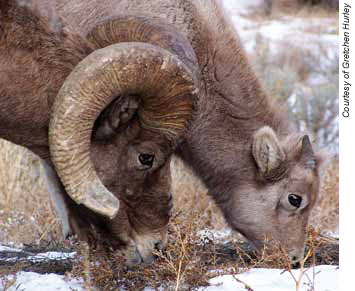Severe pneumonia outbreak kills bighorn sheep
Wildlife officials say an outbreak of bacterial pneumonia killing bighorn sheep herds in five Western states is without precedent.
Every year, a small number of bighorn sheep succumb to pneumonia, but this winter Montana, Washington, Utah, Wyoming, and Nevada all have reported unusually high incidences of sickness and death among their wild sheep populations.
The outbreak's toll is difficult to determine, since bighorn sheep roam remote locations, but officials estimate 1,000 sheep in nine wild herds had died as of early April. Some 300 of those deaths represented sick animals that were culled—a measure adopted by three states to prevent the disease from infecting other herds.

"I've been doing wild sheep work for 30-plus years, and I cannot recall a period of time when there were so many bighorn die-offs going on at once," said Kevin Hurley, the bighorn sheep coordinator with the Wyoming Game and Fish Department.
"A bad year is when you've got two or three (pneumonia-related deaths in a herd), and here you've got (many) times that," added Hurley, who chairs the Western Association of Fish and Wildlife Agencies' Wild Sheep Working Group.
The outbreak is expected to abate in the spring when herds migrate from their winter grazing lands, yet concerns about the long-term impact of the die-offs are mounting. Dr. Peregrine L. Wolff, the Nevada state wildlife veterinarian, says after pneumonia sweeps through an adult sheep population, it then kills off the lambs, and the cycle can repeat itself for several years, leading to herd stagnation.
"The population increases by ones and twos instead of 30s and 40s," Dr. Wolff explained.
The lamb die-off is the most worrisome aspect of the outbreak, according to Dr. Kristin G. Mansfield, the Washington state wildlife veterinarian. "We are really going to be monitoring our lamb survival for the next several years to see what kind of impact this disease has had and try to determine whether our interventions are having any effect," she said.
Each state is handling the outbreak differently. In Nevada, government biologists and veterinarians have been tagging herds and using radio collars to monitor them and track die-off. Additionally, more than 60 ill sheep have been darted with doses of tulathromycin, which is more commonly used to treat pneumonia in cattle.
Why this pneumonia outbreak is so widespread is hard to know. A summary of the die-offs through mid-March compiled by the Western Association of Fish and Wildlife Agencies documents instances of confirmed and probable contact between wild and domestic sheep and goats in some of the areas with the highest numbers of bighorn die-offs. Domestic sheep and goats harbor diseases to which they're immune but which are capable of causing disease in naive wild sheep.
While this interaction between wild and domestic animals may be the cause in some instances of bighorn sickness and death, it doesn't necessarily explain outbreaks in Washington, Utah, and Wyoming, where no such contact is documented to have occurred. Weather and nutritional stress may also be contributing factors.
"Everybody's looking for one common denominator, one silver bullet answer to what's going on. Unfortunately, we don't have it," Hurley said.
This June, in Oregon, the Northern Wild Sheep and Goat Council will host a workshop for affected states and others to share their latest data and the effectiveness of their response protocols so far. Long-term strategies for managing bighorn sheep populations will also be discussed.